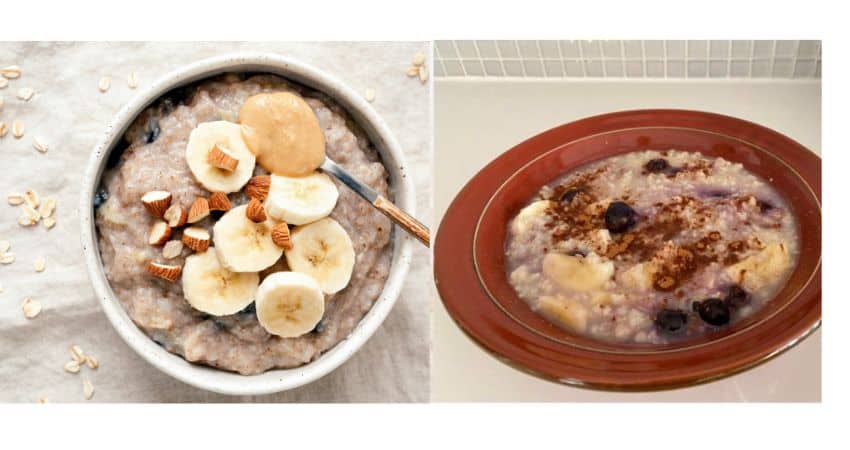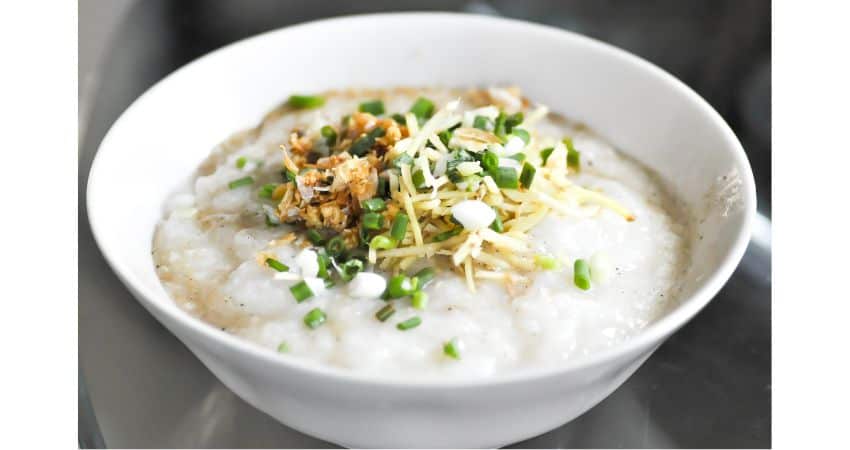Oatmeal vs Porridge: Are They The Same?
The two terms, oatmeal and porridge are often used interchangeably. For this reason, many clients attending my health coaching classes ask this common question, is oatmeal and porridge the same?
Oatmeal and porridge are not the same. Although oatmeal is a type of porridge, it’s made from ground, rolled or flattened oats boiled in water or milk. Porridge is made from a mixture of any grain, cereal or legume boiled in milk, water or broth.
This article will take a deep examination into each one and identify their differences. In addition, I’ll inform you of the various kinds of oatmeal and porridge and how they’re used.
Oatmeal vs Porridge: The Differences

As a Certified Health Coach many clients ask me about food comparisons including oatmeal and porridge. Therefore, I have researched this topic in the past and present. I consume oatmeal and porridge a few times every week. Let’s examine both foods closely.
What is Porridge?
Porridge is made from dry grains, cereals, legumes or vegetables mixed together. Depending on how it’s made, you can give it different textures and flavors by using different combinations of ingredients. It is made by boiling the ingredients in milk, water or broth.
Porridge can be made from any of the following:
- Whole oats
- Rice
- Rye
- Grits
- Corn
- Wheat

Many people use the word “porridge” to describe a hot breakfast cereal. The following fall under the Hot Cereal Category,:
- Oatmeal
- Cream of Wheat
- Cream of Rice
- Hominy Grits
- Cornmeal Mush
Cream, butter and brown sugar play a significant role in preparing every kind of porridge. Of them all, oatmeal is the only one having a distinctive flavor. The others while healthy and nutritious1, taste like whatever ingredients are added.
What is Oatmeal?

Oatmeal is a porridge made from whole grain oats with the inedible hulls removed2. However, some variations are based on how the oat grain or groat is prepared for the market.
Oat groats are seeds, which humans cannot digest, so they pass right through, without the bodies absorbing any nutrients.
Oatmeal is made by boiling the oats in water and/or milk3. There are different types including:
- Instant oats
- Quick oats
- Rolled Oats
- Steel Cut Oats
- Stone ground oats
Here are some differences in how oats are processed:
- The process of making oatmeal is one of predigestion. The groat is broken down by soaking in water overnight and then boiling until soft and creamy.
- The predigestion is sped up by cutting, grinding, or steaming the seed.
- Steel Cut oats, sometimes known as Irish Oats, are oat groats cut into pieces using a steel blade. The pieces cook more quickly than uncut grouts.
- Stone Ground oats are often called Scottish Oatmeal. Instead of pieces, the groat is crushed into small pieces which can absorb water faster, resulting in a shorter cooking time4.
- Rolled Oats are steamed and then rolled, and are sometimes labeled Old Fashioned Oats5.
- By rolling the oats thinner, results in Quick Oats. If they are rolled even thinner, it results in instant oats.
Any method results in an oatmeal porridge which means the grain is ground into a meal and cooked in water or milk until soft and thick. The nutrition level remains the same no matter which method you use to turn the oats into porridge.
How about oatmeal and oat bran? I wrote an article about their differences which may surprise you. Check out my article by clicking here, Oatmeal vs Oat Bran: A Comparison.
Different Kinds of Porridge
Wheat and Rice Porridge
A porridge made from wheat, such as Cream of Wheat is made from wheat seeds ground into a meal and cooked in water or milk. Cream of Rice is the same, but grains of rice are used. For many, these two types of porridge were their first taste of solid food.
Moms will thin porridge a bit to feed to their baby with a spoon, and some thin it enough allowing the baby to drink it from a baby bottle.
Porridge From Around The World
Other countries use their preferred ingredients to prepare a porridge which is the first solid food for their children.
- In Brazil, porridge is made from fruit and long soaked beans.
- India uses rice and lentil porridge.
- China and Japan prefer rice porridge.
- South Africa uses Maize, which is corn, to make porridge.
Pureed foods like tomato sauce or baby food do not fit into the porridge category. This is so because they are fruits and vegetables cooked into mush without grinding and soaking in liquid first.
Porridge Is Not Just for Breakfast
Whole grains, like oats, wheat, rice, corn and barley are used to make delicious breakfast porridge and loaded with nutrients6. All age groups enjoy it, and it’s an economical food. But it is not just for breakfast.
Let’s take a closer look at what else porridge is used for.
- Porridge made from cornmeal is quickly turned into a dessert pudding. Add ice cream and nutmeg, and you have Indian pudding, or as it’s called in the United States, Hasty Pudding.
- Quinoa is considered the superfood of plant-based proteins. When seasoned to suit, porridge is used as a salad, a side dish or a main dish.
- For over 4,500 years, the Chinese have been making congee, which is rice porridge. Congee is popular with most of Asia and often served for breakfast. Although some enjoy it as a satisfying lunch or supper served with some vegetables or meat.
- Polenta is corn made into a porridge Italian people once ate in some form at every meal.
- Kasha is roasted and soaked buckwheat groats cooked into a soft porridge. It has a more robust flavor brought out by roasting. It’s a popular Eastern European porridge, especially with the Jewish population, who traditionally enjoy Kasha with pasta bow ties and onions.
Some porridge, especially wheat and rice, is a bland but highly nutritious food with great texture. Because it’s bland, it can be flavored and savored any way you want. Most people start with butter, followed by sugar. After that, the flavor options are limitless.
Find out how oatmeal compared to whole-wheat bread in my article, Bread vs Oatmeal: Which is Better? A Complete Comparison.
Oatmeal or Porridge: Which is Healthier?
Oatmeal and porridge made from oats without added sugar or sodium have the similar health benefits and nutrients. When porridge is made with added sugars and other unhealthy ingredients, oatmeal is healthier with better nutrients.
Adding sugar, sodium, meat or other additives can diminish or offset the health benefits of either food. Somebody can make a porridge without any unhealthy additives and have it healthier than oatmeal with added sugar.
It’s really up to the person making either one, which one results in being more healthier. Oats are gluten free, therefore, porridge made from oats and oatmeal are good for people with celiac disease or those wishing to eat gluten free7.
Oats can sometimes get contaminated with gluten because they’re typically processed in the same facilities producing wheat, try and barley. Therefore, always check the package or manufacturer for gluten free details.
Both foods can be good for active people who need sustained energy throughout the day. With the proper additions, both foods can benefit weight loss8.
Find out if oatmeal or brown rice has the better satiety index in my article, Brown Rice vs Oatmeal: Which is Better? Let’s Compare.
Oatmeal Benefits
The table below shows the nutrient profile ((Nutrition Value: Oatmeal)) of oatmeal:
| Oatmeal, Raw (1/2 Cup) | |
| Calories | 140 |
| Fat | 2.5 g |
| Protein | 5.0 g |
| Carbohydrates | 28 g |
| Fiber | 4.0 g |
| Sugar | 0 g |
| Iron | 1.70 mg |
| Calcium | 20.00 mg |
| Potassium | 140 mg |
Oatmeal is known for the following benefits:
- Lowering cholesterol.
- Rich in essential vitamins and minerals.
- Rich in Antioxidants.
- High in fiber.
- Improve blood sugar levels.
- Weight loss.
- Improve constipation and digestion.
- Heart health.
- Lower blood pressure.
Porridge Benefits
It’s difficult to show a nutrient table of porridge because it can be made several different ways with different ingredients. Porridge made from oats has a similar nutrient profile as oatmeal. Porridge is also known to provide the following health benefits:
- Lowering cholesterol.
- Rich in essential vitamins and minerals.
- Rich in Antioxidants.
- High in fiber.
- Improve blood sugar levels.
- Weight loss.
- Improve constipation and digestion.
- Heart health.
- Lower blood pressure.
If you have any questions to ask me about this article don’t hesitate to comment below or email us. You can find an email on our contact page.
Read Next – More Food vs Food Articles!
Muesli vs Oatmeal – What’s The Difference? Let’s Compare
Instant Oatmeal vs Oatmeal: What’s The Difference?
Grits vs Oatmeal: Which is Better? A Complete Comparison
Oatmeal vs Rice: Which Is More Healthy? (We Find Out)
Wheat Germ vs Wheat Bran: What’s The Difference?
Ground Flaxseed vs Flaxseed Meal: The Differences
Overnight Oats vs Oatmeal: What’s The Difference? We Compare
- National Center for Biotechnology Information: Oat porridge consumption alleviates markers of inflammation and oxidative stress in hypercholesterolemic adults [↩]
- Oldways Whole Grains Council: Whole Grains A to Z [↩]
- University of Nebraska-Lincoln: Oatmeal – Whole Grain Goodness [↩]
- Iowa State University: Nutrition Education: Oatmeal [↩]
- Harvard T.H. Chan: Oats [↩]
- Wikipedia: Porridge [↩]
- National Center for Biotechnology Information: Oatmeal porridge: impact on microflora-associated characteristics in healthy subjects [↩]
- National Center for Biotechnology Information: Oatmeal-Containing Breakfast is Associated with Better Diet Quality and Higher Intake of Key Food Groups and Nutrients Compared to Other Breakfasts in Children [↩]
